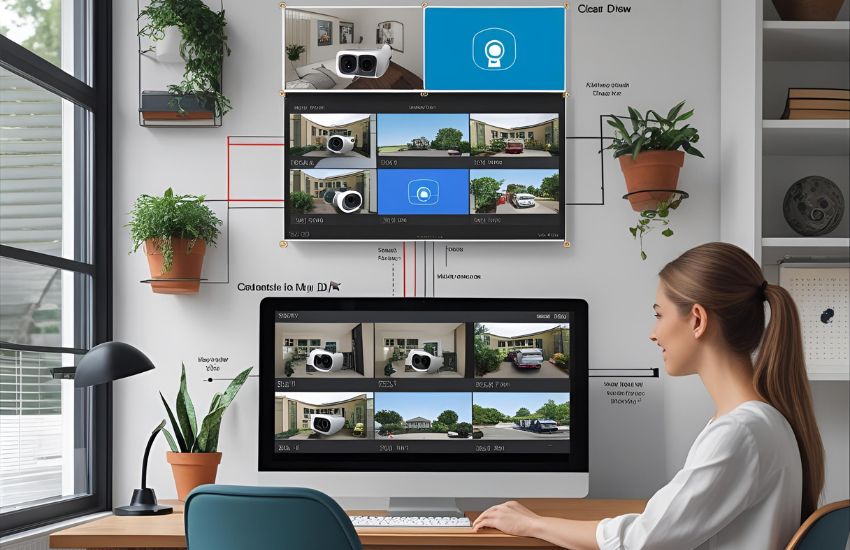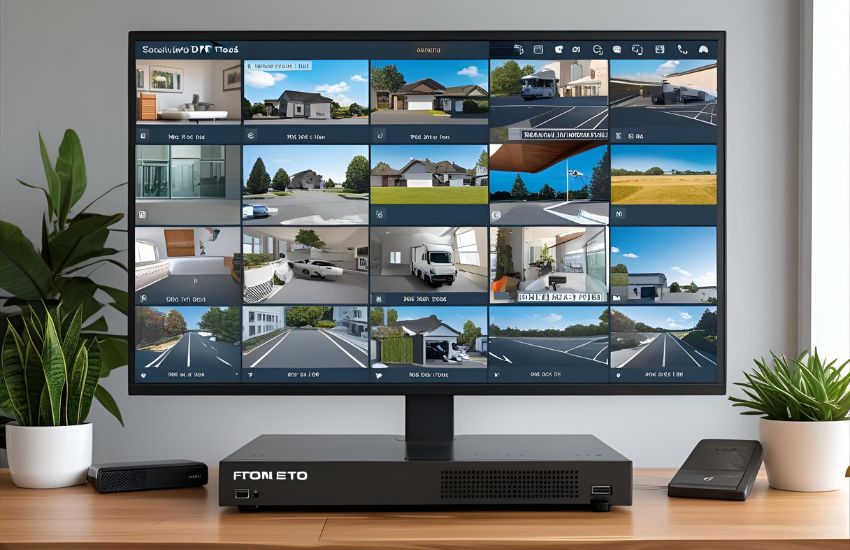Managing multiple video feeds from various cameras can quickly become overwhelming—especially when your security camera setup spans several DVRs or NVRs. Whether you’re monitoring a complex surveillance system in a commercial facility or maintaining visibility across different access points at home, viewing all your security camera DVR feeds on a single screen is essential for timely response and situational awareness.
To view multiple security camera DVR feeds on a single screen efficiently, use a DVR system with multi-channel support and a compatible monitor or video wall. Utilize the DVR’s split-screen or grid display feature, and connect through software that allows real-time monitoring. This setup ensures seamless simultaneous viewing of all camera footage for effective su.
This blog will guide you step-by-step on how to configure and view multiple DVR and NVR feeds on one screen. You’ll learn about compatible hardware and software, optimal display setups, and smart ways to integrate various video signals into a centralized monitoring interface. Whether you’re using a basic DVR or a high-end network video recorder, this guide is designed to help you take full control of your security camera system efficiently.
Streamlining Surveillance: How to View Multiple Security Cameras on One Screen Using DVRs and NVRs

Effectively managing a security camera system that includes multiple security cameras on one screen is no longer a luxury—it’s a necessity for real-time awareness and prompt decision-making. Whether you’re monitoring a home setup or a professional security environment, consolidating footage from multiple security sources enables faster response and better oversight.
Understanding DVRs and NVRs in Multi-Camera Setups
To begin, it’s important to understand the roles of DVRs (Digital Video Recorders) and NVRs (Network Video Recorders) in a surveillance system. DVRs typically work with analog cameras, while NVRs are designed for IP cameras. When configured properly, both allow you to view multiple security feeds from a variety of camera types. For complex setups involving multiple DVRs or IP camera NVRs, integrating feeds efficiently is key.
Using CMS Software to Unify Feeds
Central Management Software (CMS) is your best tool to view multiple security cameras in one place. This software allows you to connect to security camera DVRs and display multiple security cameras from different brands and locations on a single screen. Whether you’re operating from one location or overseeing multiple locations, CMS software can centralize your security cameras on one screen, simplifying monitoring and management.
Achieving Real-Time Access and Control
Modern surveillance solutions offer remote access, allowing you to view multiple camera feeds via desktop, laptop, or mobile device. This is especially useful for large video security systems or surveillance systems consisting of multiple camera types. With remote CMS access, you can monitor cameras on one screen, switch between views, and control specific feeds as needed.
Integrating Different Camera Types and Systems
If you’re using a mix of analog cameras and IP-based models like Viewtron network IP cameras, integration becomes even more critical. Advanced systems are compatible with a wide range of cameras from different manufacturers, allowing you to view multiple security feeds without compatibility issues. Solutions like iDVR-PRO DVRs are specifically designed for this purpose, bridging analog and IP setups.
See more about…Swann DVR Camera Compatibility
Best CMS Software and Remote Access Tools to Monitor Multiple Security Camera DVRs in One Place

If you’re managing an advanced enterprise surveillance system consisting of various camera types and digital video recorders, centralizing your monitoring capabilities is crucial. Whether you’re overseeing a system consisting of multiple locations or consolidating feeds within a single facility, CMS (Central Management Software) is the most effective way to view multiple cameras on one platform, regardless of brand or configuration.
Modern management software solutions are designed to simplify control of complex video systems by enabling integration of DVRs, NVRs, and even hybrid setups into one network. These tools are particularly useful for business owners who demand seamless remote oversight and consistent situational awareness. For business owners that need continuous surveillance across locations, CMS platforms include remote access capabilities that let you log in from anywhere using desktop clients or Mac software, ensuring uninterrupted visibility.
The right CMS supports compatibility with both analog and IP infrastructures, whether your video signals are recorded through BNC connectors on legacy systems or through Ethernet and PoE configurations in modern setups. Additionally, many platforms support HDMI output for high-definition display, allowing direct monitoring on a single screen or large-format display.
Some systems also support video multiplexers, enhancing control over how multiple feeds are viewed simultaneously. If you’re using Viewtron network IP cameras, for example, you can connect directly to Viewtron network IP recorders via CMS or HDMI outputs for real-time monitoring and playback.
Choosing the right software to view and manage your digital video recorders is a foundational step in building a reliable and scalable security solution. When implemented correctly, CMS not only streamlines monitoring but also enhances response time and operational efficiency across all surveillance points.
See more about…Security DVR
Conclusion
Efficiently managing multiple security camera feeds requires reliable software and hardware integration. Whether your system uses PoE IP cameras or traditional DVRs, the right CMS and remote access tools empower you to monitor all camera footage seamlessly, even if the DVR is not in-built within your network setup. This is especially important for owners that need an enterprise-level solution, where cameras and recorders are distributed across various locations but still need to be connected to the NVR for centralized monitoring. Advanced motion detectors and basic motion detection features integrated into software also enhance security by alerting you to suspicious activity promptly. Overall, investing in robust management software ensures you maintain full control and visibility, even if the DVR hardware varies across your security infrastructure.
See more about…Security DVR NVR Backup
Frequently Asked Questions (How to View Multiple Security Camera DVR Feeds on a Single Screen Efficiently)
How to view multiple cameras on one screen?
To view multiple cameras on one screen, use a security system or NVR/DVR that supports multi-channel display. Access the system via its monitor, software, or mobile app, then select “Multi-View” or “Split Screen” mode. You can arrange cameras in grids (2×2, 3×3, 4×4) to monitor all feeds simultaneously for comprehensive surveillance.
How can I see all my security cameras in one place?
To view all your security cameras in one place, use a centralized system like an NVR (Network Video Recorder) or DVR that supports multiple cameras. Install the manufacturer’s app or software on your computer or smartphone. Connect all cameras to the system, then access the live feed, allowing you to monitor multiple cameras simultaneously on a single screen.
How do CCTV operators typically monitor multiple cameras simultaneously?
CCTV operators monitor multiple cameras simultaneously using video wall displays, multi-view software, or digital video recorders (DVRs) that split screens into grids. This setup allows operators to observe several locations at once, switch between camera feeds, and focus on critical areas. Advanced systems may include motion detection alerts, ensuring efficient and proactive surveillance management.
How many CCTV cameras can one person monitor?
The number of CCTV cameras one person can effectively monitor depends on screen layout, camera type, and environment complexity. Typically, a single operator can manage 8 to 16 cameras efficiently. Exceeding this range reduces attention and response time. Modern systems with AI alerts or motion detection can increase coverage, allowing operators to supervise more cameras without compromising security.
